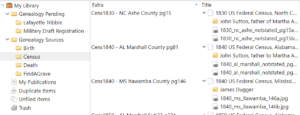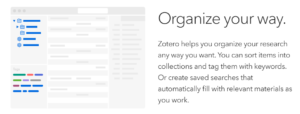After years of dancing around the idea of having separate tools for my genealogy database and my research process, I’ve finally settled on using Zotero during my research and to manage my source information, and using RootsMagic to manage and control the conclusions I draw about my family history. My only regret is that I waited so long – adding Zotero into the mix has been really beneficial.
What is Zotero
It’s a database for your research and your sources, just like RootsMagic is a database for your conclusions.
I expect that I’ll make a whole series of posts about Zotero and RootsMagic, there’s a lot to say. So let’s start with why, why two separate tools?
It’s all GEDCOM’s fault
Twenty-five years into my genealogy hobby and GEDCOM is still the standard in use for transferring information. Unbelievable, but true. It was an old and dead standard when I started, I assumed the better solution would come along soon.
I set out using my genealogy program’s special Source Templates that matched Elizabeth Shown Mills Evidence! standards. I wanted to adhere to standards (still do). I used the template fields. I spent a TON of time getting things just right. GEDCOM output of that information was basically garbage, but that didn’t matter. Bad GEDCOM output would be a short term thing, and what mattered long term was getting the source information input into the proper fields to adhere to Mills’ standards.
Flash forward 25 years and I want to make my genealogy data (currently in RootsMagic) available on the web, I want to show what I’ve got, toss out some feelers for more cousins. GEDCOM is still the way. Still. Export to GEDCOM to create the website you host using TNG. Export to GEDCOM for WikiTree or MyHeritage or Ancestry. Even if you use the new sync with Ancestry stuff, the source transfer is all freeform / full sentences rather than those lovely template fields so lovingly set up in RM.
Freeform sources in the genelogy program are the only sane solution. Input the fully written out footnote sentence into your genealogy program, and it will output via GEDCOM exactly as written.
So now what?
I use RootsMagic as my desktop program now, TNG for display on my website, and do some syncing with the Family Search Family Tree. I need all of my sources to be freeform, and for the notes that I have about those sources to be stored outside of the RM file. It just doesn’t need to be accidentally exported and gunk up my GEDCOM files.
Thus I need two separate things – a place for research/source info and a place for the lineage linked genealogy. Two separate purpose built databases.
What is there for managing research, and then creating bibliography / footnote information from that data? Zotero.
Zotero has tempted me for years
I’ve looked at Zotero, installed it, read the forums about it, for years. Of course I have. It’s the real tool for research and citation of sources. It’s a purpose built database to store the metadata about your sources in a structured way, it can output footnotes and bibliography entries to match whatever you need. It’s flexible, it’s what the pros use – it lets me “organize MY way”.
BUT…I was never able to get genealogy sources to fit into it. It was always both too much and not enough. Then there was an article about it on EOGN (https://blog.eogn.com/2018/05/08/zotero-your-personal-research-assistant/). It inspired me to have another look, to give it a more thorough try.
Read the article at EOGN to learn a bit more about the program itself, I’ll give a more thorough overview in further articles. Suffice to say, this time it worked, I gave it a more thorough run through, I was able to imagine how it would work for me.
The initial plan is to tackle the sources I have with attached exhibits – the copies of birth certificates, the copies of census pages, etc. It’s a massive project, but thoroughly necessary.
An elephant is eaten one bite at a time. The only way to get this done is to just start, and the first folder of my exhibits is “birth_records” so that’s where I started. Doing all of the records of the same type was the EXACT best way to learn how to bend Zotero to my needs, and to get used to how it works. I can build my expertise with this thing one step at a time.
That first record I entered, and then changed, then changed again a few times. Then after about 3 birth records, I decided I wanted to do something differently, so I made the change to those three, then forged ahead.
At this point, I’ve done the birth records, and am now going through my census records. WHAT A REVELATION! I now can’t imagine doing genealogy without Zotero. Just for the way I’m using it to handle census pages makes it worth the effort.
Future articles will show you exactly how I’ve done this, for now, if you’re at all curious about Zotero, go to their website and have a look around. Don’t be intimidated by the fact that there’s no “custom genealogy” source information, it will work for you, I promise!
Just have a glance at how some of these census items look in Zotero – on the left you see the groups I’ve set up so far, then you can see that each of the census pages has an entry from which t he footnote is created, then I add a note where I can write all the data on the census page, my notes, the list of people, whatever I want, and I add links to the image files, which are also linked in my genealogy database. I’ll explain it all later, but just check it out for a bit of a flavor of what you can do with Zotero for Genealogy.
he footnote is created, then I add a note where I can write all the data on the census page, my notes, the list of people, whatever I want, and I add links to the image files, which are also linked in my genealogy database. I’ll explain it all later, but just check it out for a bit of a flavor of what you can do with Zotero for Genealogy.
